Those who prefer to skip historical introductions in travel guides may travel to Fez unprepared and still return home filled with history(s). There is hardly a major city in the world that allows the traveler to participate so directly in its past. Even today, the alleys of the old city have the same course as 1,000 years ago.
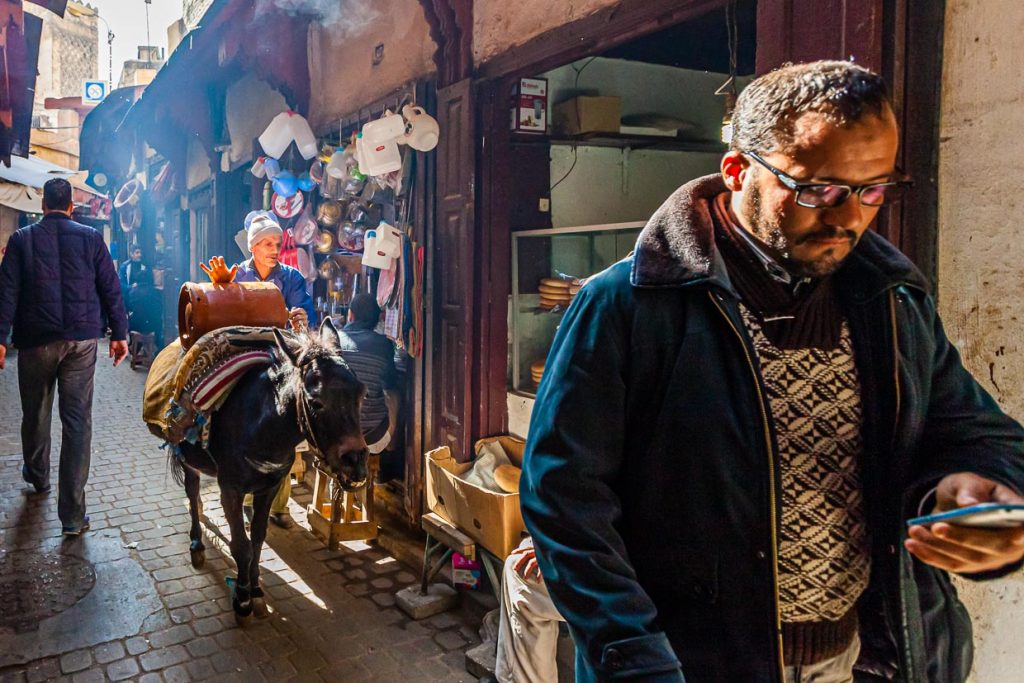
But the people who fill the city with life live in the present. With cell phones to their ears, they stay out of the way of donkeys, which are still the main means of transportation.
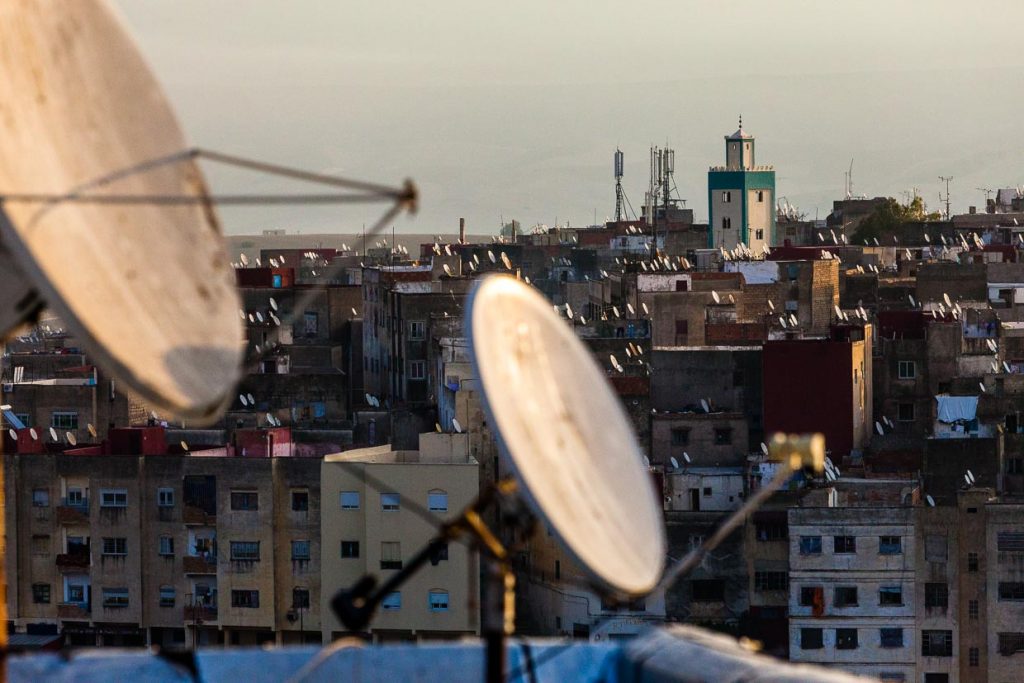
On the rooftops a myriad of satellite dishes. Strangers are approached in a friendly manner about how they are doing and whether they might want to buy something. Copper, brass and goldsmiths, woodturners, tailors, carpet dealers, bag makers, carpenters and butchers, fish, spice and vegetable dealers – all have their own quarter.
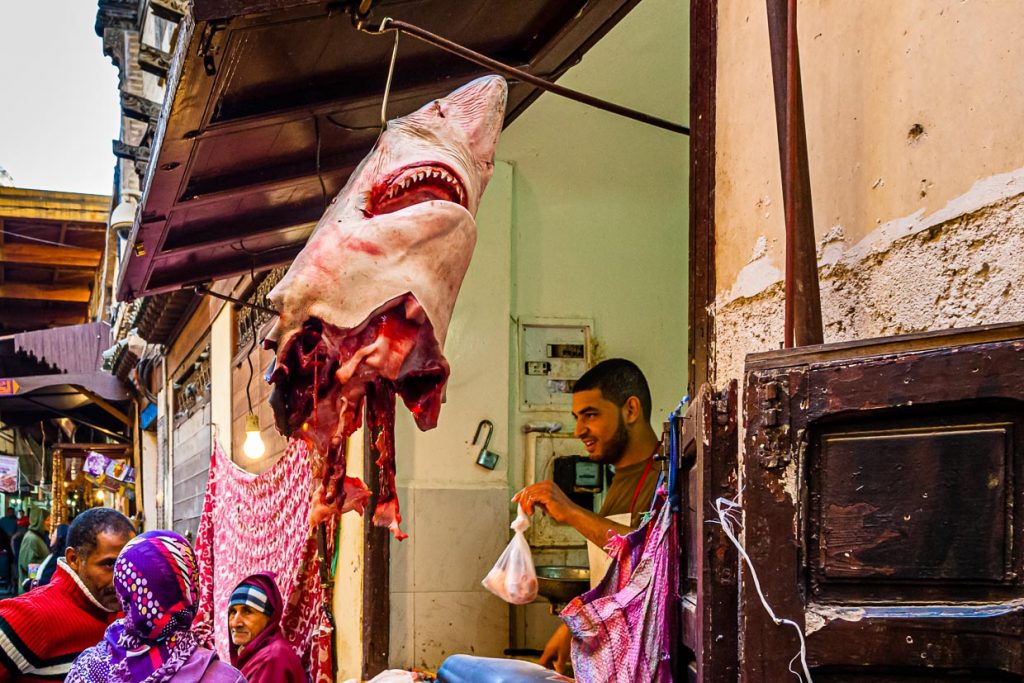
Each with its own mosque, fountain, a hammam and a bakery. Market criers try to drown out the hammering of the metal workers. Everywhere is lively until the call of the muezzin is heard. Then it gets a little quieter. Some hang cloths in front of the displays or close their stores and head for prayer in one of the 400 mosques. And that up to seven times a day.
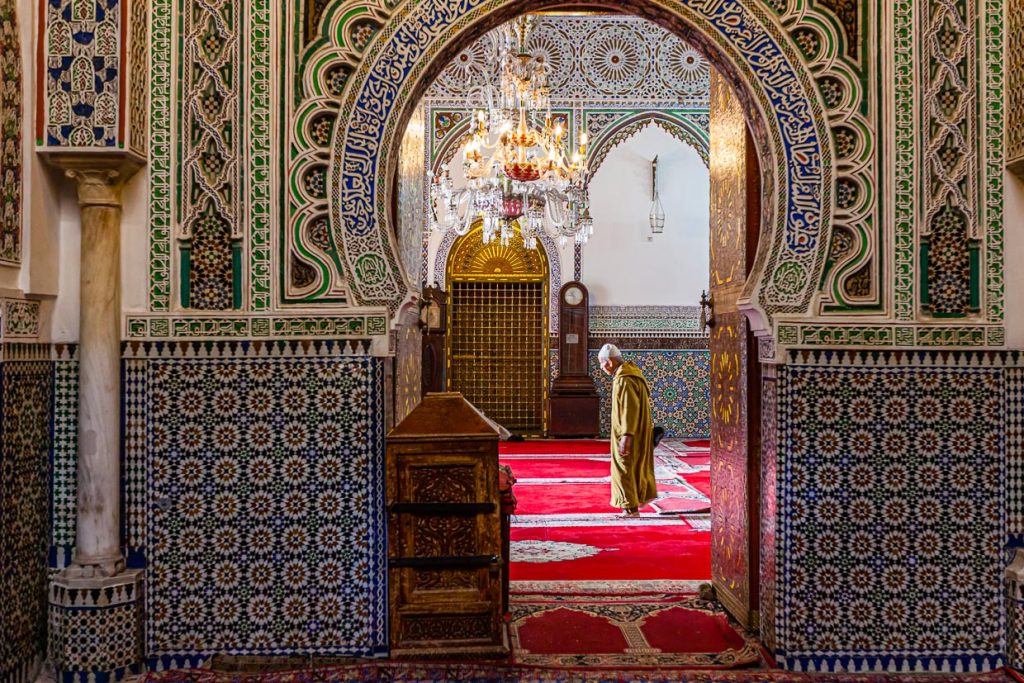
The city of Fez is the oldest of the four Moroccan royal cities and the third largest city in the country. It is considered the spiritual and religious capital of Morocco and has been declared a UNESCO World Heritage Site. The history of modern Morocco begins with the founding of the first Islamic empire by Idris, a descendant of the Prophet Mohamed. Fez is the city of handicrafts and rich in evidence of Andalusian-Moorish art.
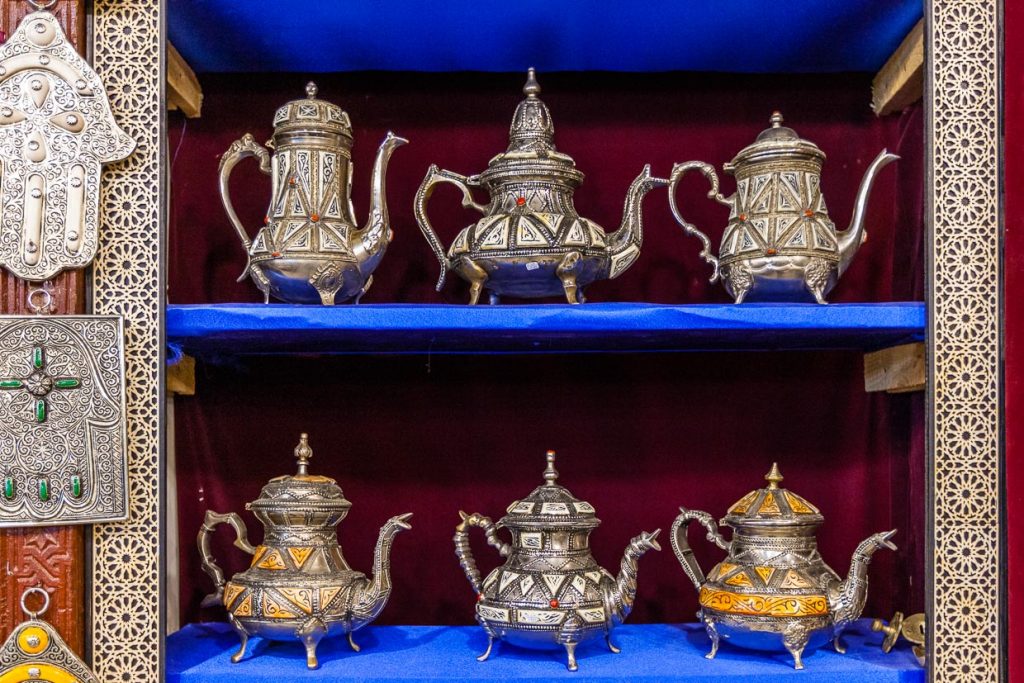
Donkey and petit cab in Fès
The history of Fès, a city of 1.5 million inhabitants, began at the end of the 8th century and is still evident in the city’s districts, which could not be more different. The oldest part is the medina Fès al-Bali, still surrounded by a city wall. Here 285,000 people live in small houses and the narrow streets offer only space for pedestrians, donkeys and small carts. All goods, all building materials, garbage collection and even sick people are transported this way.
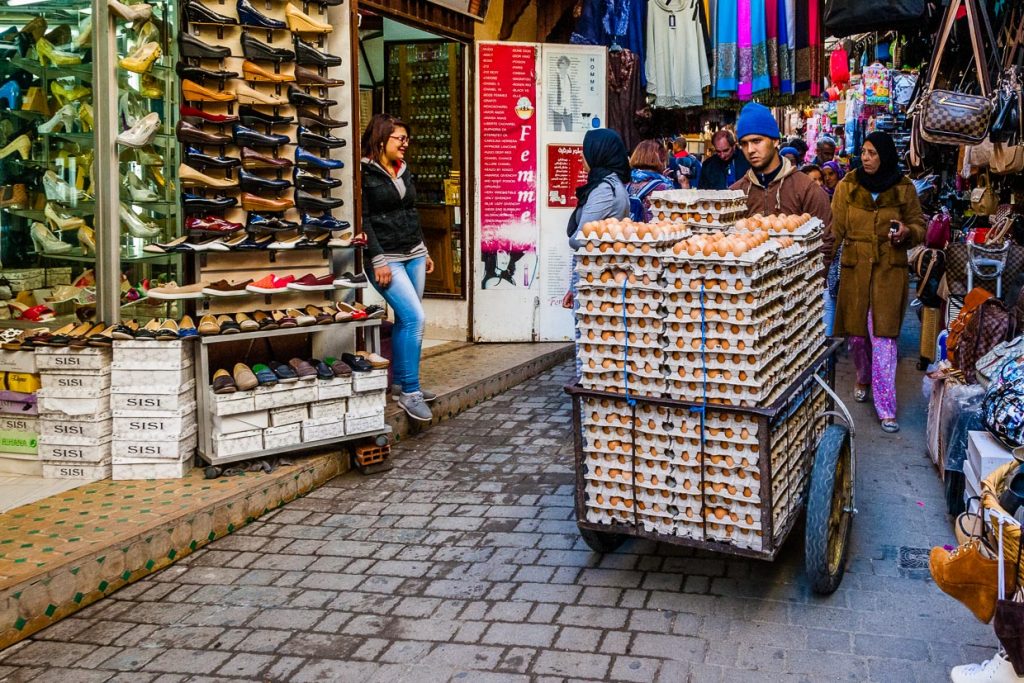
All other parts of the city can be reached by car. The small red cabs are especially cheap. A long ride across Fès costs hardly more than 5 euros. Unusual for European tourists is that the cabs are preferably used to capacity with three passengers, who share the cost of the ride. If there is still a seat available, the driver stops for another passenger and takes him along if he wants to go in the same direction.
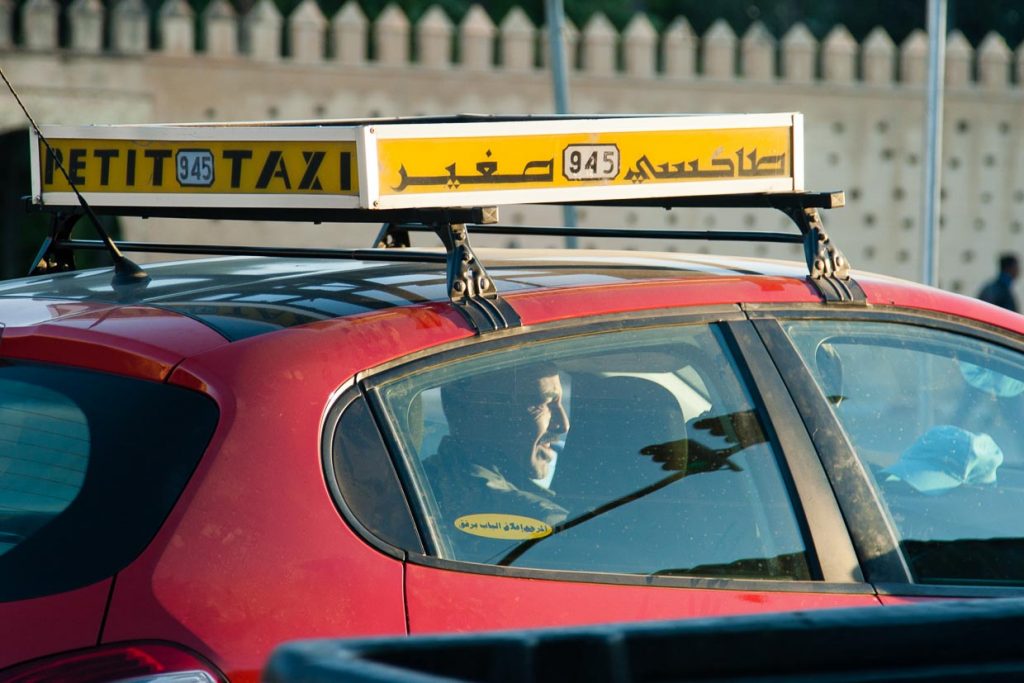
Behind high walls a hidden palace Fès el Jedid, the name means “White Fès” or “New Fès”, was built as a fortress in the 13th century. It is also home to the Mellah, the once Jewish quarter. The royal palace is hidden behind high walls on a huge area. Guards, white in summer and red in winter, stand at the gates and should not be photographed. Morocco was governed from here until the establishment of the French Protectorate in 1912.
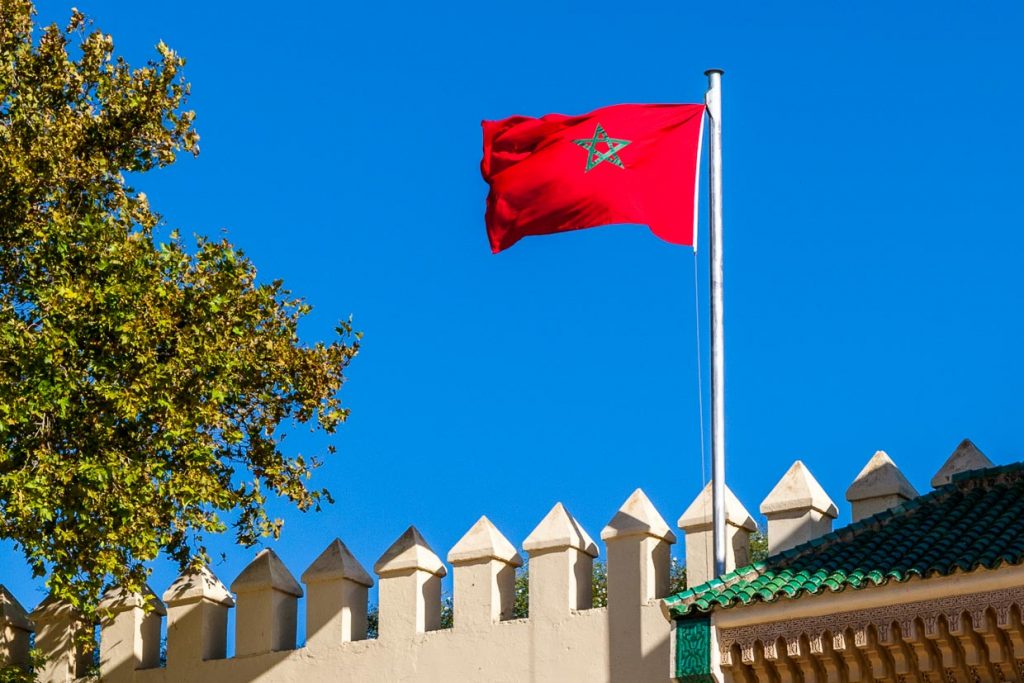
French influence
Later, further outside, the Nouvelle Ville was built for French officials and their families, with modern houses. With the departure of the French from the country in 1956, the population structure in the medina changed indirectly. The rich families moved from their old palaces to the new town, where there were suddenly many free modern apartments. Professional opportunities also lured members of the traditional extended family away from Fez. The end of the multigenerational home had arrived in Morocco. The uprooted rural population settled in the palatial riads. Where previously several generations of one family had lived, up to 20 rural families who had moved to the city from the surrounding countryside shared the habitable space, depending on the number of rooms. ORIENTation in the truest sense of the word.
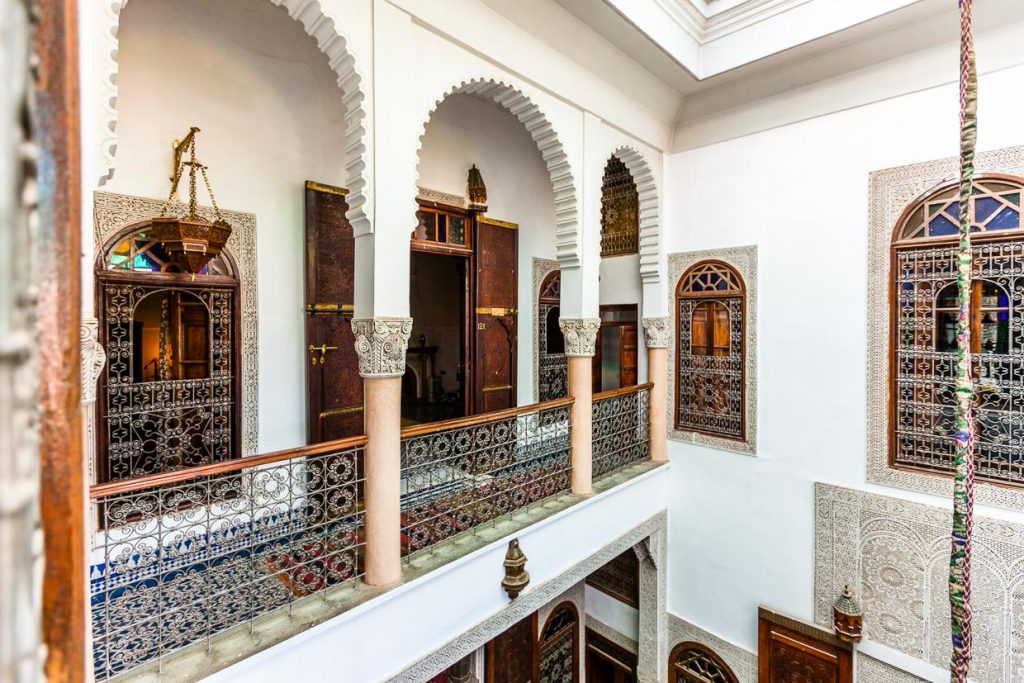
In recent years, these former patrician houses have been converted by hoteliers into luxurious accommodations. A stay of several days in one of these palaces offers several advantages to enterprising tourists. Unlike the large hotels of the periphery, the traveler soon feels at home in the Oriental Middle Ages, without having to forgo the comforts of a private retreat. Everyday life in the historic old town is within visitors’ grasp, and initial orientation difficulties can be overcome by taking more and more excursions.
Starting at Bab Boujeloud in Fez
The old city stretches over hilly terrain. Knowing which district of the old city is up or down can help with orientation. A hill to the north, where the Merinid tombs are located as a historical site, offers the best overview.

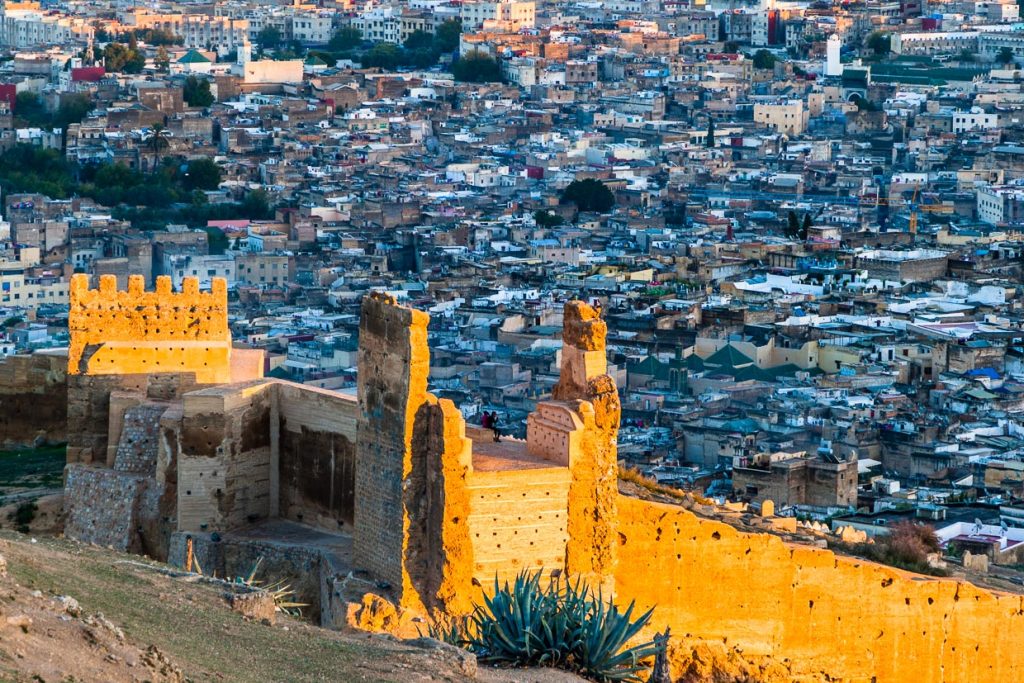
If you plan to spend only a single day in Fez, be sure to explore the old city with a licensed guide. Of the city gates, all of which have the Arabic translation Bab in their names, Bab Boujeloud is the best place to start.

In front of here, two main roads lead to the center. However, the Talaa Kebira and the Talaa Seghira are both so narrow that even for pedestrians there is at most only one lane for “oncoming traffic” in most places. A good guide will point out the basic rules in the medina and will be responsive to his clients; he will not be set on specific destinations and will prevent you from getting lost. And most importantly, being accompanied by an official guide shows the other unlicensed “guides” that they don’t even need to try their hand at being old town touts.
Baalak, baalak – “make yourself thin!”
If you hear the call “baalak” a heavily loaded donkey is on its way and its driver doesn’t give a second warning. Locals quickly squeeze between the merchants’ displays to make room. Experienced Fassis, as the people of Fez call themselves, enjoy a speedy progress by threading themselves at tail length behind such a swift beast of burden. Since all paths must be made on foot, alleys clogged by tourists are a similar nuisance to the locals as clogged highways are to us.

In the Talȃa Seghira, a small entrance magically attracts passersby. In the displays lie finely chiseled utensils made of brass. In this manufactory, the father of the reigning king commissioned from Ahmed Guernani the brass work with which the wooden gates of the wall around the royal palace were decorated between 1961 and 1968.

Today, his son Abdelgabar sits in a small corner of the store, working on a brass plate. He hammers each ornament into the metal with a small chisel. “Stencils are only used by apprentices” his brother explains in English, showing the difference on two plates.

Haggling is not just about pushing the price down
In every store and with every merchant it is also possible to talk about prices. Traditionally, however, haggling means more to people than just reducing the price. One comes into the conversation, inquires about the personal circumstances and rather incidentally the prospective buyer can inquire sometimes about one of the offered goods. Compliments are better received than when disadvantages are emphasized. Tourists should rather not open the negotiation with an object, which they want to buy finally. If the price of the presumably more expensive sample object does not move, it may well be that the “undecided” buyer will be offered a cheaper alternative. And with that, a deal can then be struck, with both sides smiling.

Closed tourist attractions in Fez
Along the way, the guide points out the city’s districts, divided by craft, and has to point out the important monuments that are otherwise easy to miss, because they are all also located along narrow streets and surrounded by stalls. Looking up, we see the Karaouiyine Mosque covered with green tiles, which is also the oldest university in Morocco. The later Pope Silvester II studied mathematics here. Today, only Muslims are allowed to enter it. So is the city’s largest sanctuary, the tomb of the city’s founder, the Zaouia Moulay Idris.
Magnificent buildings in Fez
One of the few monuments whose inner courtyard can at least be visited is the Medersa Bou Inania. The courtyard of this religious college, built between 1350 and 1357, is an impressive example of Moorish craftsmanship. With the typical Moroccan zellij called enameled terracotta tiles are laid in the Girik technique small-scale mosaics. Calligraphy and arabesques carved into the stucco adorn the walls. Minarets in Morocco almost all have a square ground plan. Few are octagonal and the slender shape have only mosques that are not financed by the state but rather by foreign foundations. They are very rare.

Colorful leather goods in Fès
What would a tour of Fès be without a look at the famous tanners’ quarter? “Tannerie, Tannerie,” young men shout, offering a special tour despite having an official guide. Here is the one spot in the entire city where tourists clearly outnumber tourists. Through one-way alleys so narrow that no oncoming traffic is possible, stairs climb higher and higher until you finally reach a balcony from which countless photographers press the shutter. Some hold mint twigs against the stench in front of nose and lens. It’s a pity that the sun only adequately illuminates the courtyard with the color pools in the morning.

In the first step, the animal skins soak in a salt solution for five days in one of the honeycomb-like basins. Another basin is filled with a lime solution. After ten days, the hair roots are dissolved and fur residues can be combed out as “dead wool”. This is not a waste product but is used as pillow and mattress filling. The leather then enters another basin, where it is tumbled several times a day with the tanners’ legs in a solution of dew endings.
The way back leads through the sales rooms of the leather cooperative. In it the tanners have united to prevent dumping prices and import leather, which was not processed after the natural methods usual in Fès.

On the edge of the tanners’ quarter, leather is processed into bags, shoes and clothing.

Booking a hotel or riad in Fès?
There are two types of accommodations in Fès. The big star hotels are located outside the city. The category rating in Morocco is not comparable to the Hotelstars Union criteria. Thus, a hotel with five Moroccan stars is equivalent to the internationally comparable comfort class of three-star superior. The hotels have many rooms and the majority of guests are group travelers who rarely spend more than one night in the same accommodation.
Travel tips Morocco, Fez
Climate: It is a good idea to visit Morocco in the low season. The climate is most pleasant from March to June and then again in October and November. In summer, the temperature is often higher than 40°C.
Telephoning: Data roaming and mobile phone calls with German contracts are expensive. 1 MB of data costs over 15 euros. For the money you can buy a prepaid card in Morocco, which covers 500 MB of data traffic. By the way, the numerous mobile phone masts occasionally disguise themselves as palm trees.

Money: The currency in Morocco is the Dirham (MAD). Conversion is easy, as 10 dirhams are roughly equivalent to 1 euro. The most common bills are 20 dirhams. Merchants often cannot give change on larger bills.
Documents: A passport valid for at least three months is required for entry.
Security: There is a lot of police in the country, uniformed but also in plain clothes. This means occasional controls, but on the other hand also few crimes against foreigners. Of course, one should not leave any valuables unattended in Morocco.

Wall calendar with photos by Georg Berg in bookstores (also online) in different sizes available: Fès – Morocco as in the Middle Ages / also as family planner (*)
This research trip was supported by the Moroccan Tourist Office
(*) This post contains advertising links (also called affiliate or commission links) that lead to Amazon.de.

